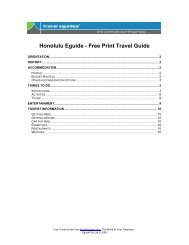Australia Eguide - Travel Guides
Australia Eguide - Travel Guides
Australia Eguide - Travel Guides
You also want an ePaper? Increase the reach of your titles
YUMPU automatically turns print PDFs into web optimized ePapers that Google loves.
88<br />
Lammeroo Beach<br />
There is a path from the grassy area to the west of the Esplanade which leads down to<br />
Lameroo Beach. The beach is fairly stony, but there are the ruins of some sea water baths<br />
down here, although only foundations remain now.<br />
Mindil Beach<br />
Mindil Beach is near the Casino and the closest beach of good quality to the central part<br />
of Darwin. It starts about two kilometres from the city centre. In the Dry Season, from<br />
May until October, this is the scene of a market every Thursday and Sunday evening,<br />
specialising in food from many countries, reflecting the diverse ethnic origins of the<br />
residents of Darwin, but including many other wares and entertainments also. Swimming<br />
is safe in this beach except for the wet season when the box jelly fish are present.<br />
Myilly Point Precinct<br />
Located here are four pre-war houses which are the headquarters of the National Trust.<br />
This, the Myilly Point Precinct, was originally housing for high-ranking government<br />
employees.<br />
Museum and Art Gallery of the Northern Territory<br />
The museum covers many aspects of the regions art, natural sciences, history and culture.<br />
Good collections of Aboriginal Art including bark paintings from Arnhem Land. There is<br />
also a display on the dramatic effects Cyclone Tracy had on the city in 1974. Highlights<br />
are the impressive Maritime Gallery and Sweetheart, the 5m stuffed crocodile. A neon lit<br />
exhibit shows the history of natural life in Darwin. The museum is set in a tropical garden<br />
on Darwin Harbour. Conacher Street, Fannie Bay.<br />
Old Courthouse and Police Station<br />
The Old Courthouse and Police Station were built for the South <strong>Australia</strong>n Government<br />
in 1884. They suffered greatly from Cyclone Tracy, but have been restored, and are now<br />
used as the offices of the Northern Territory Administrator.<br />
Old Town Hall<br />
In a small park opposite the bus station are the ruins of the Old Town Hall. It was built in<br />
1883 and survived until Cyclone Tracy in 1974. Now it has been left as a ruinous<br />
reminder of the forces of nature. Who could imagine that a sturdy stone building could be<br />
almost totally destroyed by the winds of a single night The Territory is indeed a place<br />
where one learns to respect nature.<br />
Oil Storage Tunnels<br />
After the Japanese had bombed the oil tanks on the hills in Darwin several times during<br />
the Second World War, it was decided that it might be a good idea to put the tanks<br />
underground where they would be less vulnerable. Therefore tunnels were constructed<br />
and underground storage areas built. This was all done by hand and the underground<br />
storage areas were ready just as the war finished, and so were never used. Recently one of<br />
these tunnels has been opened to the public. It contains a collection of photographs<br />
depicting Darwin during the war years. Kitchener Drive.<br />
Free from <strong>Travel</strong><strong>Eguide</strong>s.com Online <strong>Travel</strong> Information.<br />
©2008 <strong>Eguide</strong> Pty Ltd




